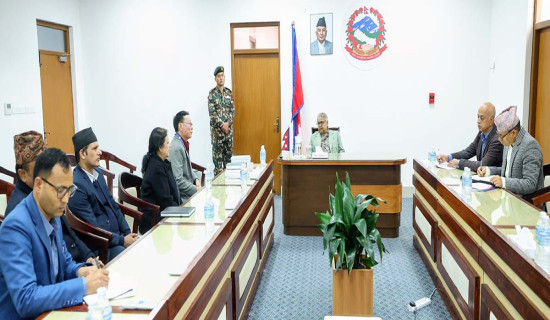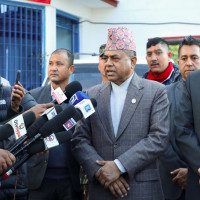- Thursday, 25 December 2025
Gadgets galore, lack of open space eclipse kite flying
By Arpana Adhikari,Kathmandu, Oct. 9: As the autumn breeze signals the arrival of Dashain, the tradition of kite flying returns to Kathmandu’s skies. However, once-vibrant tradition of kite flying, a beloved pastime associated with the festival, has been dying a slow death in recent years.
Historically, kite flying during Dashain held a deeper cultural significance. According to local lore, flying kites was a way of sending message of gratitude to the gods, particularly Indra, the rain god, for ensuring a bountiful harvest following the monsoon season.
A decade ago, the skies over Kathmandu Valley used to be studded with colourful kites, and neighbourhoods would engage in friendly ‘kite battles’. Flyers competed to cut down each other’s kites, and the joyful shout of ‘Changa Chaitt!’ echoed through the streets, celebrating each victory.
Today, however, the scene has changed. Modernisation, a lack of open space, and the pervasive influence of technology have left the once contested skies relatively empty. Children, more often glued to their phones and tablets, are losing touch with the simple outdoor joys that once defined the festive season.
However, some people and businesses are determined to keep this cherished tradition alive, passing it on to the younger generation.
Individuals like Santosh Neupane refuse to let the tradition die. For Neupane, who was spotted in Ason selecting kites for his children, it’s more than a holiday activity, it’s about reliving his childhood memories and passing them on to next generation.
“I remember how we used to fly kites for hours during Dashain. It wasn’t just fun; it was an essential part of the festival,” he added.
“Competing with friends, trying to cut each other’s kites, and shouting ‘Changa Chaitt!’ after cutting down other’s kite was all part of the excitement,” Neupane recalled, smiling at the memories from his childhood in Chabahil. “Nowadays, kids are so engaged with gadgets. I want my children to experience the same joy we did. But they lack open space and also interest in outdoor activities.”
Saurya Poudel, 10, of Kumarigal was busy selecting colourful kites at the same store shared how his father passed down the art of flying kites, and he has been practising for the last two years.
“My friends and I compete to cut each other’s kites, but we can’t chase them like my father used to, because there’s no open space in our neighbourhood,” he said, highlighting how urbanisation has impacted the tradition.
Saurya’s mother, Durga Poudel, also weighed in on the issue. “I’ve bought a dozen kites for my son. With the Dashain holidays, he is more focused on flying kites than on screens,” she said.
While she is encouraged to see more people in her neighbourhood flying kites this year, she notes with nostalgia that Kathmandu has lost much of the kite-flying charm she used to witness in her childhood. For Prakash Shrestha, a 26-year-old from Shovabhagwati, kite flying is a way of reconnecting with his past.
While purchasing kites and thread at a store in Ason, he reminisced about his childhood, when flying kites was a major part of Dashain celebration.
“When I was a kid, I flew kites passionately. But over the years, with work pressure, gadgets, and the lack of open space, that passion faded,” he said. However, this year, he has decided to pick up the practice again, hoping to pass on the tradition to his nephews. “It’s been three years since I last flew a kite, but this year, I’m making a comeback,” Prakash added.
Interestingly, his office, Cedar Gate Nepal, is also organising a kite-flying competition among its staff members, a trend that seems to reflect a broader resurgence of the tradition.
Kite sellers in Ason have also noticed this revival as well. Ajay Chitrakar, vendor of the 75-year-old Shree Chitrakar Store and Kite Centre, reports a noticeable increase in sales this year compared to previous years.
“In previous years, fewer people bought kites because children were more interested in gadgets. But this year, it’s different. More parents are buying kites for their kids,” Chitrakar said.
He noted that while they haven’t kept track of the exact number of visitors to the shop, business has been non-stop since the start of the Dashain holidays.
Another kite vendor, Abhi, of Abhi Kite Centre, Ason who wished to keep his surname private, shared a similar story.
“I’ve sold at least 50,000 kites this season. It feels like the tradition is making a comeback, especially among the younger generation,” he said.
This revival can be partly attributed to the growing awareness among parents to pass down the tradition to their children. Many believe that kite-flying also offers a break from digital distractions. As the tradition of kite flying during Dashain fades, organisations like Kites Nepal are working to preserve it.
Founded by Bikal Chaulagain, the company promotes the cultural practice through kite-making camps and competitions, especially for children.
“The idea behind Kites Nepal was to preserve the culture and keep it alive,” he said, adding, “It’s essential that we pass these traditions down to the younger generation.”
This year, Kites Nepal has planned its annual kite flying competition between Dashain and Tihar, with the event scheduled to take place at Skywalk, Kamaladi.
The company has been distributing between 400 to 500 kites annually to underprivileged children, ensuring that even those who may not be able to afford kites can still participate in the tradition.







-square-thumb.jpg)








